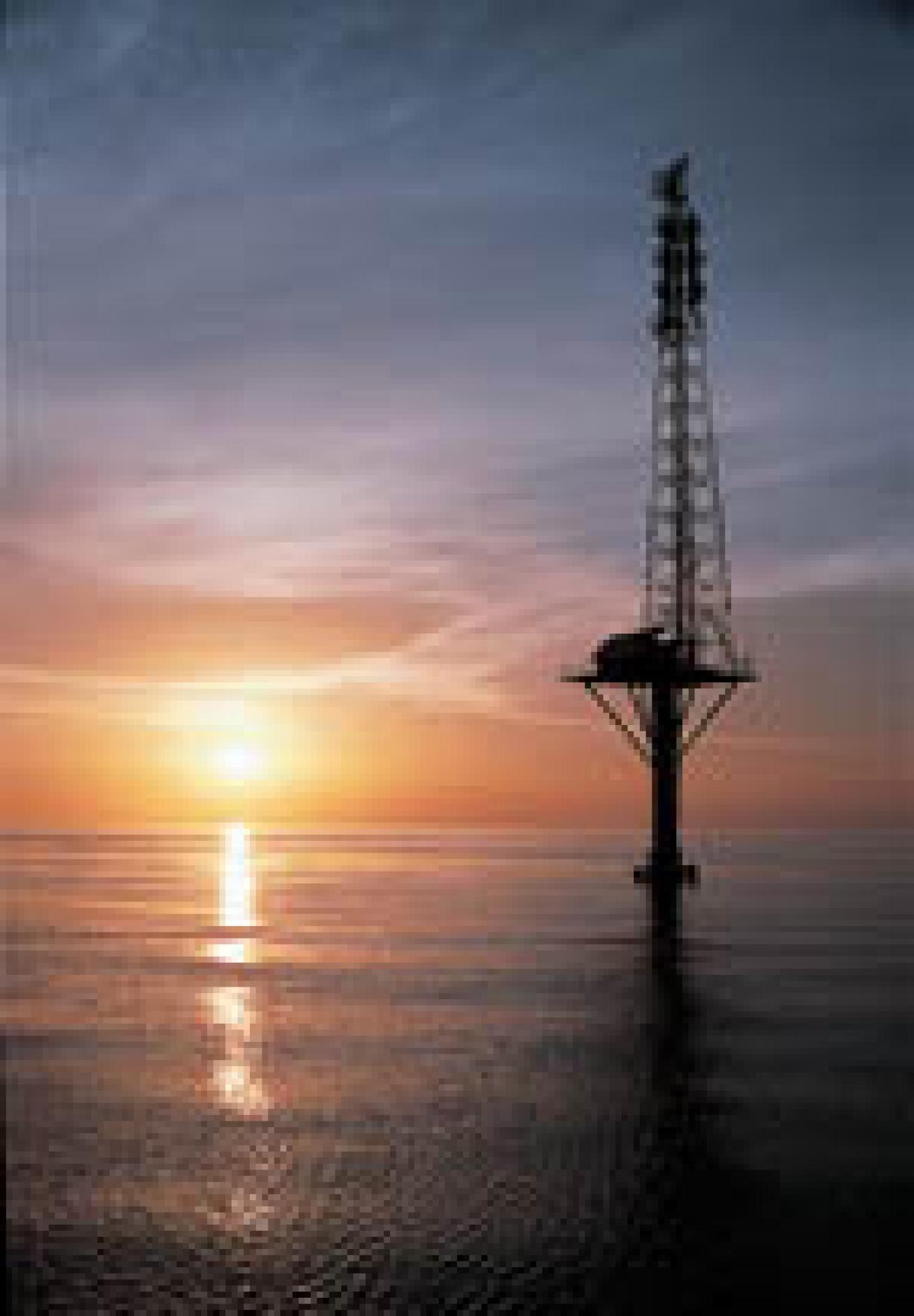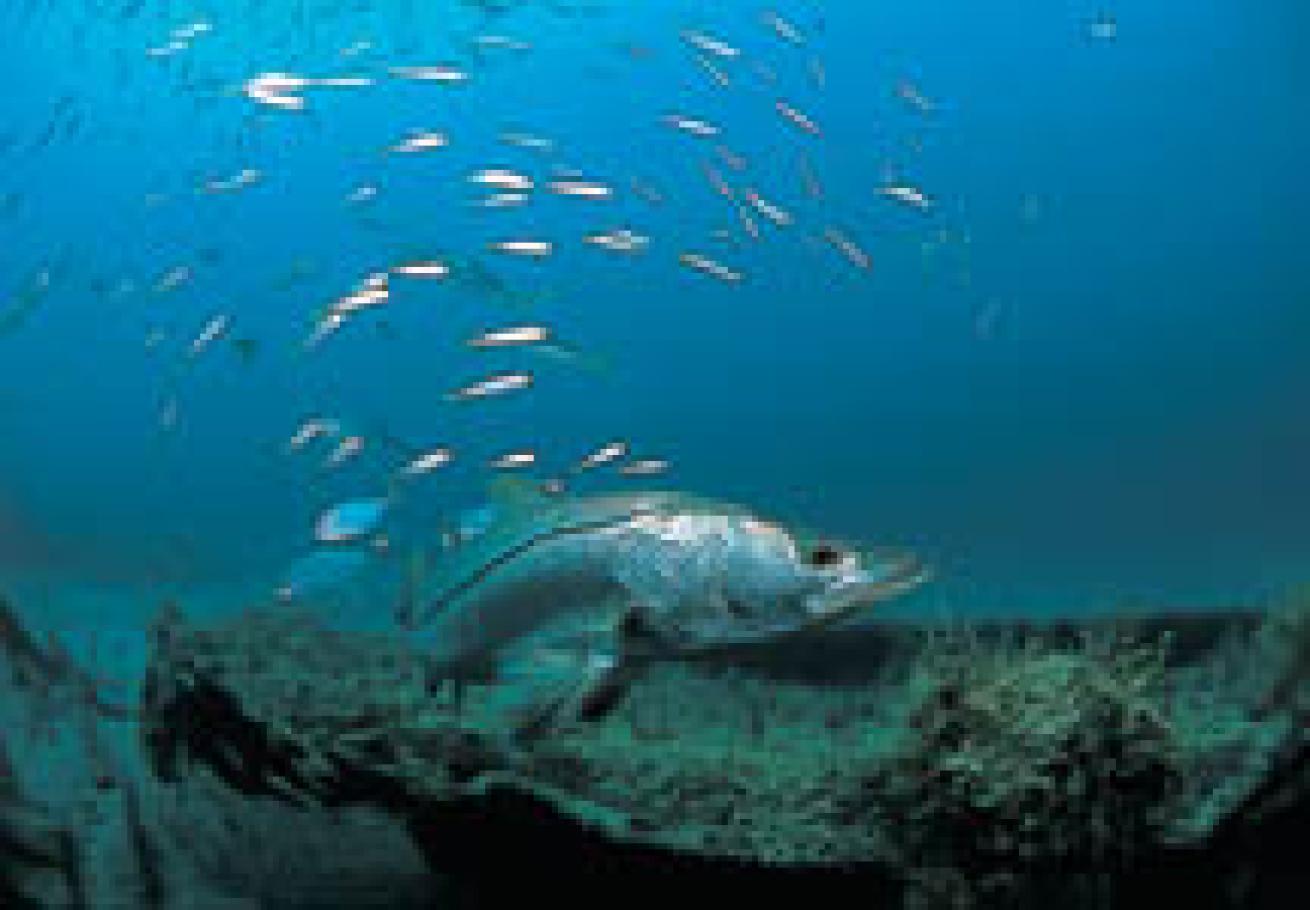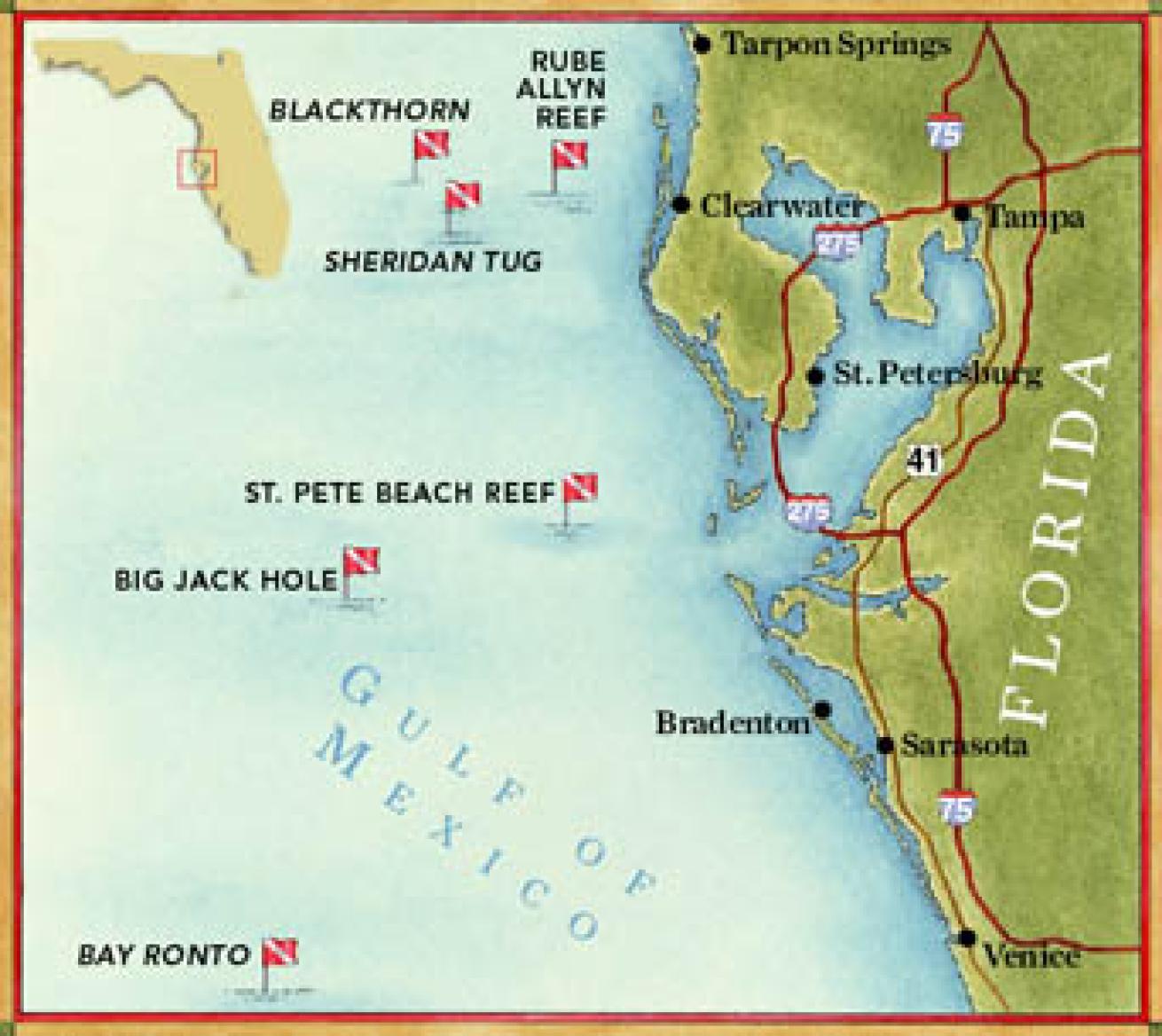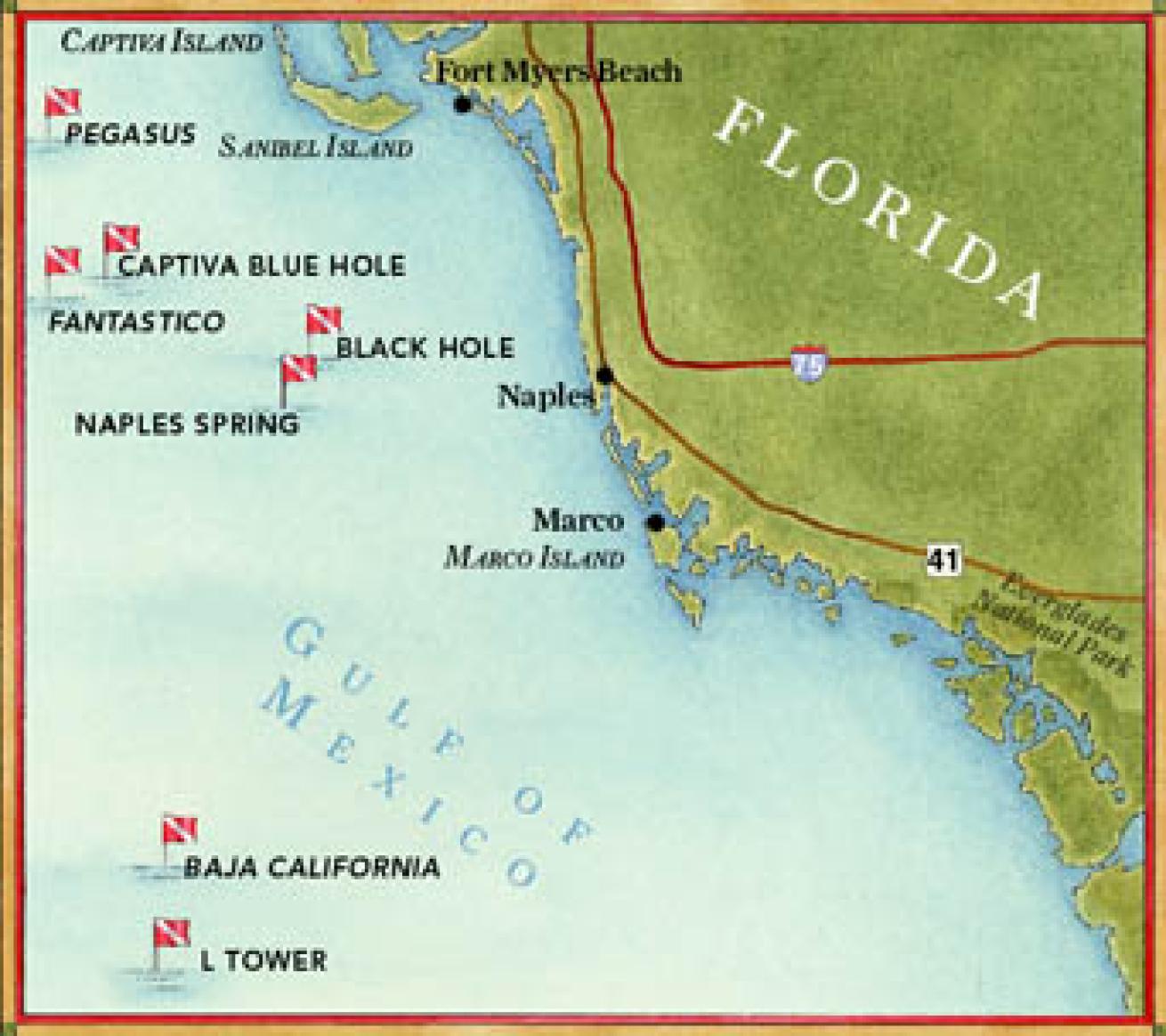Diving Florida's Wild West on Its Gulf of Mexico Coast
 |
| At L Tower, Goliath grouper patrol the structure's massive steel legs. |
Florida's Gulf of Mexico west coast may not have Caribbean-like coral gardens in crystalline seas, but it boasts enough excitement in the fish department to send a scuba diver's pulse racing. All along the state's central and southern gulf coast, encounters with big, bold and in-your-face fish are guaranteed to take place.
Anyone planning to dive this region for the first time should be aware that its marine geography is desert-like, broader and flatter than anywhere else in the state. To reach depths greater than 100 feet often requires runs as far as 40 miles off the coast. In addition, the few natural formations that exist on the bottom--mostly ledges--are usually miles apart. Consequently, most dive charters between Tampa in the north and Naples in the south are conducted from swift, 28- to 40-foot long-range craft, handling groups of six to 12 divers apiece.
Air Force Relay Towers
 |
| L Tower |
We woke to another day of calm seas. The sky, devoid of any visible horizon, merged seamlessly with the cerulean waters of the Gulf of Mexico. Save for our boat and the offshore radio relay tower to which we were tied, the only anomaly in this field of blue was another dive vessel, sitting in the middle distance.
We'd come here, some 50 miles off the coast of Naples, to dive the Air Force Relay Tower known simply as L, one of several erected in gulf waters to provide telemetry information to jet fighters. But despite the visual tranquility, the scene was far from peaceful. Overhead, a horn blared repeatedly. To prevent ships from colliding with these 300-foot steel structures during night crossings or bad weather, the towers are fixed with flashing beacons and incessant horns, though they're not always working. I hurriedly assembled my gear, motivated not only by anticipation of the dive but also by the urge to escape the nerve-grating racket.
 |
| Spadefish cruise the gulf's towers, wrecks and ledges. |
Relief came as soon as I slipped into the gulf's warm waters. And action soon followed. Like a lone oasis in the desert, L Tower sits in 110 feet of water, its growth-covered legs creating a focal point for fish that would otherwise roam the deep. With underwater real estate at a premium, the schools stack up with a density usually seen only in places like Cocos and Galapagos Islands.
The first 20 feet of the water column was dominated by patrols of four-foot-long great barracudas that prowled in tight-packed formations. Adult great barracuda are not known to exhibit schooling behavior. Was this a hunting tactic? Or a mutual protection pact? And if so, protection from what?
Below, schools of spadefish, permit and crevalle jack circled the tower's thick legs in polarized packs, while large numbers of mangrove snappers dominated the spaces between the supporting braces. Dropping closer to the bottom revealed the coup de theatre of the dive: Clustered around the bases of the tower's four massive legs were 33 huge Goliath groupers.
Indigenous to Florida, these gargantuan members of the grouper family are capable of growing to enormous proportions. In 1961, a specimen taken off Fernandina Beach, Fla., entered the record books at 680 pounds. Although the largest of the uber-groupers we saw during our dive may have tipped the scales at a mere 350 pounds (we're talking a 55-gallon drum with a tail), an aggregation of this magnitude meant we were face-to-face with some five tons of grouper.
Gulf Coast Wrecks
 |
| Snook find sanctuary in the gulf's shipwrecks. |
Through the years, the gulf's sparse bottom terrain has been augmented by a number of steel-hulled shipwrecks, downed during severe storms or sunk by German U-boats. For fish communities, these incidental additions to the seabed provide needed refuge, as welcomed as a truck stop on a desolate road.
One of the region's most popular wrecks is the Baja California, which came to rest not far from L Tower in 115 feet of water. A 266-foot freighter, the now-tattered Baja received a single torpedo to her bow in 1942 from U-84 of the German wolf pack. Like the tower, the wreck is a habitat of choice for large numbers of groupers and snappers, as well as for many varieties of pelagic fish. On a recent visit I saw a 15-foot-long baby whale shark, escorted by several four-foot-long cobia. The wreck is also a noted hot spot for underwater hunters, but those with itchy trigger fingers should stay clear of the large-and-in-charge Goliath groupers, a federally protected species. Don't even think of hunting one, or the next person you see might be the man behind the bench.
Northeast of the Baja, off the coast of Venice, is the equally enticing 400-foot-long Bay Ronto. Sunk by a hurricane in 1919 while en route from Galveston to France, the British steamer rests keel-up in 110 feet of water. Schools of barracuda, groupers, snappers, sea turtles and sharks, as well as several Goliath groupers, make their home here.
Due south of the Bay Ronto is the Fantastico, a 200-foot Honduran freighter sitting upright in 112 feet of water. This ship had the misfortune of running head-on into the Gulf of Mexico's famed "storm of the century" in 1993, losing four of its crew in the process. Its hull and rigging are still intact, adding an interesting backdrop to the abundant fish life.
 |
| Map by Jane Shasky |
Artificial Reefs
To add to the gulf's anthology of wrecks, several coastal communities have enacted aggressive artificial reef programs, sinking everything from ships and barges to demolished bridge sections and decommissioned military vehicles.
Tampa, St. Petersburg and Clearwater's hit parade includes the Rube Allyn Reef, which is an excellent place to look for kingfish that are attracted to the reef's tall pyramid structures and a 35-foot barge that sits atop concrete bridge pilings and light poles. The Sheridan Tug, a 180-foot-long ocean tug upright in 80 feet of water is 100 yards southeast of the Blackthorn, a 180-foot-long Coast Guard cutter, now broken in three pieces, resting in 80 feet of water. For a different venue try St. Pete Beach Reef, which is comprised of several Army tanks in about 35 feet of water and often features schools of large snook and other reef fish.
Off Fort Myers, the Pegasus is a 100-foot-long ocean tug sitting upright in 90 feet of water. Since its placement in July 1999, it has attracted masses of fish life and impressive growth.
Sinkhole Central
While the majority of Florida's gulf diving consists of ledges and wrecks, the region is not without one big surprise: drowned sinkholes, akin to the blue holes found in the Bahamas and Belize. But what distinguishes the gulf's collection of circular well shafts is their starting depth.
Off Tampa/St. Pete is famed Big Jack Hole. Although small in diameter--just 25 feet across--the hole begins its drop at 110 feet and descends to uncharted depths from there. What gives this hole its name is quickly apparent: its resident population is dominated by jacks-- crevalle, almaco and greater amberjack. During the spring and summer months, the site is also known to attract large schools of spadefish, great barracuda and permit.
Farther south, in the Fort Myers/Naples area, is a threesome of these unusual formations. The closest to the coast, some 27 miles southwest of Gordon Pass, in 65 feet of water, is the Naples Black Hole. Spanning 100 feet in diameter, this massive sinkhole drops more than 215 feet. Inside its circular shaft, the walls follow an hourglass shape, tapering at 115 feet. Nearby is the Naples Spring, an 82-foot-wide hole in 70 feet of water, with a well shaft that plummets to 224 feet.
The Captiva Blue Hole (popularly--and misleadingly--known as the Crack) has a circular opening that starts at 85 feet, while the sink bottoms out at 180. Approximately 32 miles southwest of Boca Grande, the ancient blue hole features numerous undercuts in the shaft's limestone walls, harboring everything from octopus to regal sea goddess nudibranchs to spiny oysters. And since Florida's gulf waters are always teeming with outsized creatures, don't be surprised if a dive into the Captiva Blue Hole reveals a giant loggerhead turtle napping under a ledge.
 |
| Map by Jane Shasky |
Travel Guide
Water Conditions > Water temps in this part of the Gulf of Mexico vary widely between winter and summer. Although typically warmer than Florida's Atlantic coastal waters, temps drop from the mid-80s in the summer to the low 60s between January and March. Water clarity, which averages 25 to 50 feet near shore, improves to 80 to 90 feet once you're 20 to 40 miles offshore
|| |---|
|
| |At L Tower, Goliath grouper patrol the structure's massive steel legs.|
Florida's Gulf of Mexico west coast may not have Caribbean-like coral gardens in crystalline seas, but it boasts enough excitement in the fish department to send a scuba diver's pulse racing. All along the state's central and southern gulf coast, encounters with big, bold and in-your-face fish are guaranteed to take place.
Anyone planning to dive this region for the first time should be aware that its marine geography is desert-like, broader and flatter than anywhere else in the state. To reach depths greater than 100 feet often requires runs as far as 40 miles off the coast. In addition, the few natural formations that exist on the bottom--mostly ledges--are usually miles apart. Consequently, most dive charters between Tampa in the north and Naples in the south are conducted from swift, 28- to 40-foot long-range craft, handling groups of six to 12 divers apiece.
Air Force Relay Towers
|| |---|
|
| |L Tower|
We woke to another day of calm seas. The sky, devoid of any visible horizon, merged seamlessly with the cerulean waters of the Gulf of Mexico. Save for our boat and the offshore radio relay tower to which we were tied, the only anomaly in this field of blue was another dive vessel, sitting in the middle distance.
We'd come here, some 50 miles off the coast of Naples, to dive the Air Force Relay Tower known simply as L, one of several erected in gulf waters to provide telemetry information to jet fighters. But despite the visual tranquility, the scene was far from peaceful. Overhead, a horn blared repeatedly. To prevent ships from colliding with these 300-foot steel structures during night crossings or bad weather, the towers are fixed with flashing beacons and incessant horns, though they're not always working. I hurriedly assembled my gear, motivated not only by anticipation of the dive but also by the urge to escape the nerve-grating racket.
|| |---|
|
| |Spadefish cruise the gulf's towers, wrecks and ledges.|
Relief came as soon as I slipped into the gulf's warm waters. And action soon followed. Like a lone oasis in the desert, L Tower sits in 110 feet of water, its growth-covered legs creating a focal point for fish that would otherwise roam the deep. With underwater real estate at a premium, the schools stack up with a density usually seen only in places like Cocos and Galapagos Islands.
The first 20 feet of the water column was dominated by patrols of four-foot-long great barracudas that prowled in tight-packed formations. Adult great barracuda are not known to exhibit schooling behavior. Was this a hunting tactic? Or a mutual protection pact? And if so, protection from what?
Below, schools of spadefish, permit and crevalle jack circled the tower's thick legs in polarized packs, while large numbers of mangrove snappers dominated the spaces between the supporting braces. Dropping closer to the bottom revealed the coup de theatre of the dive: Clustered around the bases of the tower's four massive legs were 33 huge Goliath groupers.
Indigenous to Florida, these gargantuan members of the grouper family are capable of growing to enormous proportions. In 1961, a specimen taken off Fernandina Beach, Fla., entered the record books at 680 pounds. Although the largest of the uber-groupers we saw during our dive may have tipped the scales at a mere 350 pounds (we're talking a 55-gallon drum with a tail), an aggregation of this magnitude meant we were face-to-face with some five tons of grouper.
Gulf Coast Wrecks
|| |---|
|
| |Snook find sanctuary in the gulf's shipwrecks.|
Through the years, the gulf's sparse bottom terrain has been augmented by a number of steel-hulled shipwrecks, downed during severe storms or sunk by German U-boats. For fish communities, these incidental additions to the seabed provide needed refuge, as welcomed as a truck stop on a desolate road.
One of the region's most popular wrecks is the Baja California, which came to rest not far from L Tower in 115 feet of water. A 266-foot freighter, the now-tattered Baja received a single torpedo to her bow in 1942 from U-84 of the German wolf pack. Like the tower, the wreck is a habitat of choice for large numbers of groupers and snappers, as well as for many varieties of pelagic fish. On a recent visit I saw a 15-foot-long baby whale shark, escorted by several four-foot-long cobia. The wreck is also a noted hot spot for underwater hunters, but those with itchy trigger fingers should stay clear of the large-and-in-charge Goliath groupers, a federally protected species. Don't even think of hunting one, or the next person you see might be the man behind the bench.
Northeast of the Baja, off the coast of Venice, is the equally enticing 400-foot-long Bay Ronto. Sunk by a hurricane in 1919 while en route from Galveston to France, the British steamer rests keel-up in 110 feet of water. Schools of barracuda, groupers, snappers, sea turtles and sharks, as well as several Goliath groupers, make their home here.
Due south of the Bay Ronto is the Fantastico, a 200-foot Honduran freighter sitting upright in 112 feet of water. This ship had the misfortune of running head-on into the Gulf of Mexico's famed "storm of the century" in 1993, losing four of its crew in the process. Its hull and rigging are still intact, adding an interesting backdrop to the abundant fish life.
|| |---|
|
| |Map by Jane Shasky|
Artificial Reefs
To add to the gulf's anthology of wrecks, several coastal communities have enacted aggressive artificial reef programs, sinking everything from ships and barges to demolished bridge sections and decommissioned military vehicles.
Tampa, St. Petersburg and Clearwater's hit parade includes the Rube Allyn Reef, which is an excellent place to look for kingfish that are attracted to the reef's tall pyramid structures and a 35-foot barge that sits atop concrete bridge pilings and light poles. The Sheridan Tug, a 180-foot-long ocean tug upright in 80 feet of water is 100 yards southeast of the Blackthorn, a 180-foot-long Coast Guard cutter, now broken in three pieces, resting in 80 feet of water. For a different venue try St. Pete Beach Reef, which is comprised of several Army tanks in about 35 feet of water and often features schools of large snook and other reef fish.
Off Fort Myers, the Pegasus is a 100-foot-long ocean tug sitting upright in 90 feet of water. Since its placement in July 1999, it has attracted masses of fish life and impressive growth.
Sinkhole Central
While the majority of Florida's gulf diving consists of ledges and wrecks, the region is not without one big surprise: drowned sinkholes, akin to the blue holes found in the Bahamas and Belize. But what distinguishes the gulf's collection of circular well shafts is their starting depth.
Off Tampa/St. Pete is famed Big Jack Hole. Although small in diameter--just 25 feet across--the hole begins its drop at 110 feet and descends to uncharted depths from there. What gives this hole its name is quickly apparent: its resident population is dominated by jacks-- crevalle, almaco and greater amberjack. During the spring and summer months, the site is also known to attract large schools of spadefish, great barracuda and permit.
Farther south, in the Fort Myers/Naples area, is a threesome of these unusual formations. The closest to the coast, some 27 miles southwest of Gordon Pass, in 65 feet of water, is the Naples Black Hole. Spanning 100 feet in diameter, this massive sinkhole drops more than 215 feet. Inside its circular shaft, the walls follow an hourglass shape, tapering at 115 feet. Nearby is the Naples Spring, an 82-foot-wide hole in 70 feet of water, with a well shaft that plummets to 224 feet.
The Captiva Blue Hole (popularly--and misleadingly--known as the Crack) has a circular opening that starts at 85 feet, while the sink bottoms out at 180. Approximately 32 miles southwest of Boca Grande, the ancient blue hole features numerous undercuts in the shaft's limestone walls, harboring everything from octopus to regal sea goddess nudibranchs to spiny oysters. And since Florida's gulf waters are always teeming with outsized creatures, don't be surprised if a dive into the Captiva Blue Hole reveals a giant loggerhead turtle napping under a ledge.
|| |---|
|
| |Map by Jane Shasky|
Travel Guide
Water Conditions > Water temps in this part of the Gulf of Mexico vary widely between winter and summer. Although typically warmer than Florida's Atlantic coastal waters, temps drop from the mid-80s in the summer to the low 60s between January and March. Water clarity, which averages 25 to 50 feet near shore, improves to 80 to 90 feet once you're 20 to 40 miles offshore










